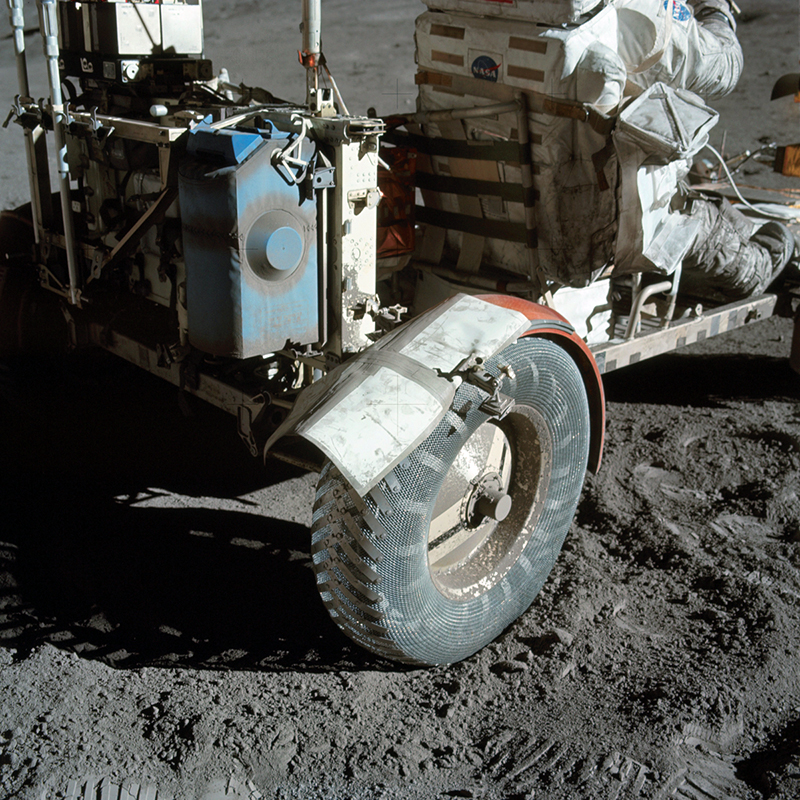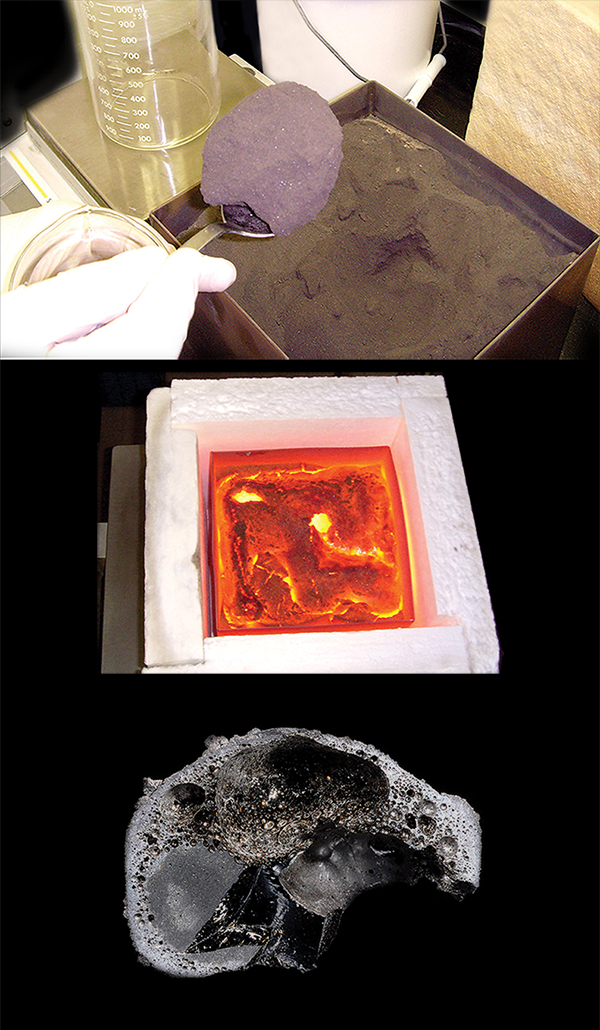
Models Support Energy-Saving Microwave Technologies
NASA Technology
During the Apollo Program, astronauts on the Moon encountered a small menace that created big problems: lunar dust. Similar to how tiny bits of Styrofoam behave on Earth—adhering to anything they touch—lunar dust sticks to spacesuits, spacecraft, tools, and equipment, and is extremely difficult to remove. The clingy nature of the substance is partly due to its electrostatic charge but is also due to its physical characteristics: The sharp, irregularly shaped grains have edges like burrs and feel like abrasive talcum powder to the touch.
Not only a nuisance, Moon dust is also a potential health and safety risk. Because it is often laden with ultraviolet radiation and high iron content, it can be detrimental if it gets into the eyes or lungs. In fact, some of the particles are so small that the human body does not even detect them in order to expel them. On the Apollo missions, equipment covered with the dark-colored Moon dust suffered from the absorption of sunlight and tended to overheat.
NASA has investigated tools and techniques to manage the sticky stuff, including magnets, vacuums, and shields. In 2009, Kennedy Space Center collaborated with a small business to investigate a method to harden the Moon’s surface—in a sense, to “pave” the surface—so astronauts and robots could land, drive, and work without disrupting and scattering the material.
Partnership
Kennedy awarded Small Business Innovation Research (SBIR) funding to Troy, New York-based Ceralink Inc., a leader in the development of microwave processing technologies, to demonstrate a microwave system that could heat lunar soil to over 2,000 ?F, temperatures high enough to solidify the surface. The company performed demonstrations using microwave technology, which could be incorporated into a roving lunar system, to heat the surface of a large bed of 8-inch deep simulated lunar soil.
“When you heat the dust, it densifies or melts, becoming glassy and hard,” says Holly Shulman, president and CTO of Ceralink. “The technology could potentially be used to make miles of road on the Moon.”
The technique employed through the SBIR applied microwave heat only to the surface of a material rather than an entire object. In addition to demonstrating this new approach, Ceralink also examined the feasibility of using computer modeling software to simulate microwave heating on a larger scale.
As part of the SBIR, Ceralink teamed with Rensselaer Polytechnic Institute (RPI) and Gerling Applied Engineering to investigate and refine the computer modeling technology. This opportunity allowed the team to test the modeling program against an experiment. “By the end of the project, the model was at the point where it was matching up very well with what we were doing in the lab,” says Shawn Allan, Ceralink’s principal investigator on the project. “We had experiments and also a computer model that was backing up our experiments.”
As a result, the team advanced a computer modeling capability that is now incorporated into Ceralink’s commercial services.
Benefits
Ceralink specializes in microwaves, materials, processing, and design, providing microwave technology for research and manufacturing of ceramic materials, glass, metals, and polymers. The company’s microwave testing center boasts a range of heating equipment for a variety of processes, and when customers are interested in exploring microwave heating, Ceralink performs the tests in its lab. “The customer might be interested in energy savings, or running their process faster, or looking to see if they can get better properties by using microwave,” says Allan.
Thanks to the NASA SBIR, the company is now using the resulting computer modeling technology to predict how materials like ceramics, metals, and glass behave with microwave heat. The new capability is like having an extra tool, says Allan. “We can do the experimental work, and we can also model what we are doing. That’s an ability for us that we didn’t really have before the NASA project.”
The program allows Ceralink to take what is learned from a process developed in the lab for a small microwave furnace and apply the information to simulate how the same process would work in a much larger furnace. The company simply inputs the material properties, and the model runs the specific configuration, including the amount of microwave power that would be required on a larger level. “It makes us better prepared to help our customers scale up microwave heating for manufacturing,” says Allan.
Ceralink is currently using the NASA-enhanced program for a U.S. Department of Energy project to design and test microwave technology for cracking hydrocarbons like ethane and turning it into ethylene for making plastics like polyethylene and polyester. “The process takes long chains of hydrocarbons and breaks them down to make other things like ethylene gas. A microwave is being used to crack it down as an energy-saving method,” says Shulman.
The model has applicability for other Ceralink customers as well. For example, the company recently built a system for making specialty carbon foam for composites tooling for aircraft, spacecraft, and automobiles. The process required the materials to be heated to over 1,800 ?F, and with conventional heating methods, it took 1 week to fire the material. With a small system developed in Ceralink’s lab, the firing was complete in less than a day. Together with other companies, Ceralink built a successful larger system, but, as Allan says, “If we had the modeling tool at the time, it would have helped to simplify the design and building of the system.”
Allan also envisions use for the modeling program for tape cast machine applications, which move materials on a belt through a microwave; for alumina substrates for electronics and computers; zirconia for solid oxide fuel cells; and other electronics ceramic materials that go into capacitors and resistors, fuel cell materials, and battery materials.
As the new tool impacts Ceralink’s current innovations, it has the potential to impact NASA’s future developments. In 2011, the company began working on an SBIR to apply microwave technology for curing epoxy composites for aircraft, helicopters, and spacecraft. “We are currently developing it in our lab on a small scale, but I’m optimistic,” says Allan. “If we proceed in the development, the model will be very helpful.”
modeling capability that is now incorporated into Ceralink's commercial services.

Through an SBIR with Kennedy Space Center, Ceralink Inc. demonstrated a microwave system that could heat lunar soil enough to solidify it. The images above show simulated lunar soil before, during, and after Ceralink’s microwave heating. As a result of the SBIR, Ceralink refined a computer modeling program that is now offered as part of Ceralink’s commercial services.

When the fender of a lunar rover suffered damage, astronauts on Apollo 17 repaired it with maps, clamps, and duct tape. Without a fender, the rover kicked up a plume of abrasive lunar dust that stuck to the astronauts and their equipment.













